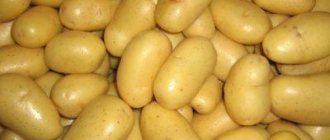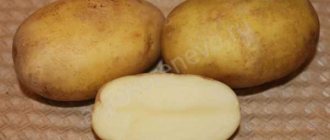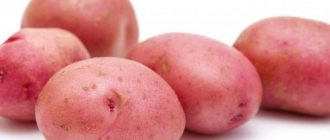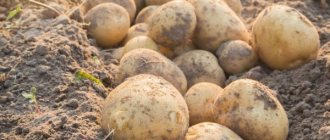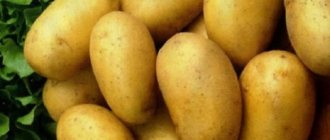Potato care
The culture requires constant care.
Untimely watering or hilling entails a delay in the growth and development of the plant. In this case, it will not be possible to get an extra-early harvest. The soil around the crop should be constantly soft. This will ensure unobstructed air access to the roots. Loosening is carried out every time a crust forms on its surface.
Rules for caring for potatoes:
- A week after planting potatoes, the soil is loosened with a rake or harrow. If it quickly becomes overgrown with weeds, these activities are repeated after a week.
- After the rows are formed, the nightshades are treated with a hoe, thereby destroying the weeds.
- A plant 15-22 cm high is covered with earth so that it does not bend or break in the wind.
Some vegetable growers believe that it is not worth hilling plants in hot, dry summers if it is not possible to provide regular watering. The tubers will simply “bake” in the ground. You can’t do this on a hot sunny day when the ground is dry.
Plants need good care
In northern latitudes, where summers are cool and it rains often, it is necessary to hill up the crop. This will protect the plant from frost and get rid of weeds.
Watering
Timely watering is a prerequisite for high crop yields. Watering the plant depends on weather conditions, region and soil moisture. If it rains frequently, this event can be forgotten until the crop blooms.
During the entire growing season, three abundant waterings are sufficient:
- during the appearance of the first shoots;
- at the beginning of flowering;
- after flowering.
The Zorachka variety is sensitive to drought; in such weather it requires regular watering. Drooping leaves are a signal for urgent watering. This is done in the late afternoon and at least 3 liters of water are poured under each bush. Watering methods:
- into holes or furrows:
- sprinkling.
It is better to use the first method, since the second can cause fungal diseases. The soil around the crop must be loosened by hand every other day.
Fertilizer
The crop is fed three times throughout the growing season. Fertilizers are applied for the first time 3-4 weeks after planting. In southern latitudes this is done in May, in northern latitudes - in June. For 1 m2 take about 10 g of urea, 20 g of superphosphate and 10 g of potassium sulfate. Fertilizers are dissolved in water and the crop is watered. If there is drip irrigation, it is enough to scatter fertilizers along the rows. Lush and dark green tops indicate excess nitrogen. In this case, mineral fertilizers can be replaced with bird droppings (200 g of droppings per 1 m2).
- The second feeding is carried out after the buds appear, the third - after the plant has bloomed.
- Foliar feeding is carried out 2-3 times. The bushes are sprayed with a 2% solution of a mixture of superphosphate, potassium chloride and Bordeaux mixture.
- This will not only fertilize the plants, but also protect them from disease conditions and pests.
Pest treatment
Pests and disease conditions lie in wait for crops everywhere, and so that this does not affect the yield, it is necessary to know the measures to combat them.
Pests and ways to combat them:
- A mole cricket eats the tubers of a young plant. It can be identified by “moves” that are clearly visible. Pest control measures: when planting a crop, place a sprig of pine needles per 1 m2; fill the passages with a solution of laundry soap; the passages fall asleep. The pest will leave the area and go away.
- Potato moth attacks plants in southern latitudes, where they are grown twice a year. Caterpillars that eat leaves are dangerous. They are treated with Bankol and Fosbecid preparations according to the instructions.
- Spider mites colonize the reverse side of the leaves, they turn yellow and fall off. Preventive measures: removing the remains of previous plants from the soil, disinfecting greenhouses.
- The Colorado potato beetle eats the leaves, flowers and stems of the plant. Biological pest control measures: plants are regularly inspected, beetles, their eggs, larvae are collected and destroyed. Chemical methods: crops are treated with the preparations “Mospilan”, “Killer”, “Stop Zhuk”.
Potato diseases - rhizoctonia
In addition, tubers sometimes rot. The cause is late blight, common scab or dry rot. These painful conditions can be easily prevented by proper planting and harvesting of tubers.
Harvest and storage
Tubers of the early-ripening Zorachka variety begin to be dug up a month and a half after planting, in mid-June. Mass harvesting occurs 70-75 days after planting - in mid-July - early August.
3-5 days before harvesting potatoes, cut off the tops (they are left only near bushes intended for obtaining seed material for the new season). Potatoes dug up during this period are dried and stored in a cellar or basement at a temperature of 8-10 degrees.
Until the next season, only seed material is stored, having previously treated it with a solution of copper sulfate to prevent fungal diseases.
Potatoes of the Zorachka variety are a young crop, but have proven themselves. Summer residents like her:
- unpretentiousness to conditions and care;
- stable yield;
- disease resistance;
- good taste.
Farmers earn income by cultivating these early ripening potatoes.
If you find an error, please select a piece of text and press Ctrl+Enter.
Harvesting
Tubers of the early variety Zorachka for young potatoes are dug up a month and a half after the growing season. Farmers sell it in the market, making a good profit. Before harvesting for storage, which is done after another 30 days, the tops are cut off and left on the most developed bushes, from which seed material is harvested. Potatoes dug up at this time are dried and placed in a basement or cellar.
Summer residents and gardeners love to grow the Zorachka variety, because it is quite unpretentious in care, undemanding to the fertility of the soil, the tubers have an excellent taste, ripen quickly, and are good for both cooking and frying.
As mentioned above, early-ripening and young potatoes can be dug up 45-50 days after sunrise. This variety fully ripens by 80 days.
For the first time (for young potatoes), Zorachka tubers are dug up 1.5 months after planting, after which the products can be sold. To harvest for storage, the crop is kept in the ground for another 30 days. To do this, the tops are cut off, and on the most developed bushes they are left in order to subsequently prepare seed material. Tubers dug up during this period need to be dried and then stored in basements or cellars.
If Zorachka potatoes are harvested 2.5 months after planting, the crop will not rot and will not lose its taste, and during transportation it will retain commercial quality or can last without spoilage until January. It is not for nothing that the Belarusian potato variety Zorachka is loved by summer residents and gardeners. It is easy to care for, undemanding to soil, early ripening, good taste and excellent commercial qualities of tubers.
Potato variety Zorachka
Zorachka is a Belarusian early-ripening potato variety (Solanum tuberosum) for table use. Brought out by employees of the Republican Unitary Enterprise "NPC NAS of Belarus for Potato and Fruit and Vegetable Growing." In 2013, it was included in the state register of breeding achievements of the Russian Federation. Approved for cultivation in two regions of the country: Northwestern (Vologda, Kaliningrad, Kostroma, Leningrad, Novgorod, Pskov, Tver, Yaroslavl regions) and Central (Bryansk, Vladimir, Ivanovo, Kaluga, Moscow, Ryazan, Smolensk, Tula regions). It is characterized by low boilability of tubers. Does not tolerate drought well and is relatively resistant to mechanical damage.
It takes about 70-75 days from emergence to full ripening, but the first potato harvest can be harvested on the 45th day of the growing season.
The plant is of an intermediate type, semi-erect, low, sometimes growing to medium height. Zorachka's leaves are medium in size, intermediate in type, green in color. The flowers are red-violet.
On one plant, 9−12 homogeneous, evenly aligned tubers with an average weight of 92−119 grams are formed. They have an oval shape, sometimes elongated. The peel is yellow and smooth to the touch. The pulp is light yellow in color. The eyes are small and shallow.
During state tests in Russia, the variety proved itself very well. Marketable yield was recorded at 254−316 c/ha, which is comparable to the Zhukovsky early and Artemis standards. On the 45th day of the growing season, during the first digging, it was possible to collect 143−251 c/ha, at the level of the Pushkinets and Zhukovsky early standards. On the 55th day after full germination, during the second digging, in different regions, from 199 to 280 centners of potatoes per hectare were obtained, at the level and 86 centners/ha higher than the Zhukovsky indicators. The maximum yield was recorded in the Tula region - 383 c/ha, 143 c/ha more than the Dolphin standard. Marketability is high - 80−96%, shelf life is also excellent - 96%.
The taste is good, Zorachka is classified as culinary type AB. The tubers are slightly cooked, so they are best suited for frying, preparing salads, soups and vegetable mixtures. They will also perform well as boiled new potatoes. The starch content in the pulp is 12.7−14.2%.
The plants are not picky about soil and climate, but the originator himself notes that this variety is better suited for growing on light and medium-textured soils, that is, sandy loam and loose loam. Our hero is quite simple in agricultural technology, but if you pay more attention to him, he will definitely respond to this and make you happy! So, if you provide the plants with sufficient mineral nutrition, the share of marketable tubers will increase, and their number in general. You should be careful about watering - do not allow the soil to dry out or become waterlogged.
The originator of the variety provides recommendations on planting density. When cultivating for personal consumption or selling commercial potatoes, about 50-55 thousand tubers are planted per hectare of area, or 500-550 pieces per hundred square meters. If you want to grow seed material, you should plant 60-65 thousand tubers per hectare, or 600-650 per hundred square meters.
Zorachka is resistant to golden cyst nematode and canker, but is susceptible to virus Y. It is moderately resistant to late blight on tubers and tops.
This variety is very popular among gardeners for its unpretentiousness in care and undemandingness to soils and climate. It has spread quite widely across household plots in many parts of Russia. Another main advantage is considered to be the excellent keeping quality of tubers - according to reviews from potato growers, they can be stored until next year even in an apartment, without losing their consumer qualities. It should also be noted that it has good taste, resistance to diseases, and fairly high yield.
Our hero is distinguished by early tuberization and rapid accumulation of crops in the first half of the growing season, so you can start digging up young tuber crops very soon after planting.
Disadvantages include the plants’ poor resistance to drought, as well as their susceptibility to the Y virus. Otherwise, Zorachka is a very good potato, one of the most popular early-ripening varieties bred by Belarusian breeders.
Advantages and disadvantages
Belarusian potatoes are valued for their excellent taste, stable immunity to a number of diseases, and fast growing season. The advantages are also noted:
- high product characteristics;
- easy care;
- the possibility of industrial cultivation of the variety;
- earlier maturation;
- good yield indicators (up to 40-45 t/ha).
Despite the fact that Zorachka is an early ripening potato, if necessary, the tubers can be stored in the cellar for up to 4 months. The variety is suitable for beginner gardeners, as it requires minimal care. This potato is resistant to diseases, manages to “escape” late blight due to its early stages, but at the same time has a high immunity to infection.
"Minuses":
- potatoes require watering, but in temperate regions they do well without additional irrigation (usually there is enough precipitation);
- low starch content;
- low resistance to viral infections.
Otherwise, there are no problems when growing. Yield indicators do not decrease even in an unfavorable season for the crop.
Characteristics and features of the variety
Zarochka potatoes can produce their first harvest forty days after planting. Full ripening of root crops occurs in 80 days.
The bush is medium-sized; its height usually does not exceed 60 centimeters. There are quite a lot of leaves on it. Zorachka potato variety has light blue flowers; they are densely collected inflorescences of medium size.
Zorachka variety
Root vegetables are dark yellow in color. There are few ocelli, and they are located far from each other. The description of Zorachka's potatoes says that his potatoes are round and their skin is smooth. In terms of starch content, this potato variety is in the middle position - usually 13%. The potatoes are quite hard and practically uncooked. One tuber often reaches 150 g in weight.
One bush produces no more than twelve tubers. The yield per hectare is 340 centners. Compared to other varieties, it is average.
This variety is preserved well during transportation. On average, 96% of potatoes remain intact.
In cooking, this variety is more convenient to use in salads or when cooking.
Zorachka variety
Features of planting and growing
Potatoes are planted in May, when the soil warms up to a temperature of +7...+10°C. The soil is suitable: loamy, forest, peat, sandy loam. To improve the quality of the soil, sand, lime, and humus are added.
Preparing for landing
Tubers for planting are prepared in the fall, after harvest. To do this, thick, strong bushes are dug up, the tubers are dried for several days, avoiding direct sunlight. Select undamaged potatoes the size of a chicken egg and store them separately from the rest of the crop.
Two weeks before planting, the tubers are germinated by placing them in a warm place and laying them out in boxes in one layer. Sprinkle with sawdust, which is periodically sprayed with water - this way the potatoes germinate faster. Then it is covered with cloth or paper so that the sun's rays do not cause harm.
Planting scheme and technology
The site is dug up, humus and compost are added. The holes are dug at a distance of 35-40 cm from each other, the gap between the rows is 55-60 cm. Large tubers are planted to a depth of 10 cm, smaller ones - to 7 cm.
During the planting process, the ground is additionally fertilized with a nutrient mixture consisting of 150-200 g of peat, 1 tbsp. l. wood ash, 2 tsp. superphosphate. The collection is mixed with soil and a handful is placed in each planting hole.
Features of cultivation
The main feature in the process of growing the variety is abundant watering with mandatory loosening of the soil. Otherwise, agricultural technology does not differ from that applicable to other types of potatoes.
Choose an open, sunny place. Planted in May: in the northern regions - at the end of the month, in the southern regions - in the middle. Following the rules of crop rotation will help increase the yield - potatoes grow well after leafy vegetables, cabbage, carrots, and beets.
To achieve an even distribution of sunlight, the beds are located from north to south.
Nuances of care
It is better not to plant potatoes next to other plants of the nightshade family: tomatoes, peppers, eggplants, which are susceptible to attacks by the Colorado potato beetle. The presence of pumpkins and cucumbers suffering from late blight in neighboring areas is also undesirable.
It is proper care of potatoes, including watering, loosening, hilling, and processing of bushes that preserves the characteristic properties of the Zorachka variety and increases the mass of tubers by 20-25%.
Watering mode
The first watering is carried out after green bushes with a height of at least 20 cm appear on the surface. The next watering is carried out during the budding period, when tubers are formed. After flowering ends, the bushes are not watered to avoid late blight.
The optimal amount of liquid for one plant is 3 liters. The next day after watering, the soil around the bushes is loosened.
Top dressing
If a sufficient amount of complex fertilizer is added to the ground when planting potatoes, you will need to fertilize the soil three times during the growth period:
- Two handfuls of humus for each bush before the first hilling.
- Dissolve 30 g of potassium sulfate in 10 liters of water, add the solution per 1 square meter. m of beds or 200 g of wood ash at the beginning of flowering.
- Apply an infusion of 10 liters of water, 50 g of superphosphate, 200 g of mullein under each bush in an amount of 500 ml during the flowering period.
At the beginning of growth, use an organic nettle fertilizer. To prepare it, fill a bucket 70% with grass, fill it with water, and leave to infuse for 14 days. Dilute the infusion with water in a ratio of 1:20 and water the crop.
Disease and pest control
The Zorachka variety is characterized by strong immunity to nematodes, cancer, and is relatively resistant to late blight of stems and fruits, but is exposed to the Y-virus:
- Late blight appears at high humidity - about 90% - and an ambient temperature of +15-20°C. It appears as dark spots on the outside of the leaves and light spots on the back. Since it is useless to fight the disease, to prevent its spread to neighboring plants, diseased potato bushes are removed at the first signs of its manifestation.
- The Y virus can reduce crop yields by 70%. When signs appear in the form of yellow curled foliage, falling of the leaf blade, or the appearance of dark brown angular necrotic spots, the bushes are disposed of.
Features of agricultural technology
One of the main qualities of Zorachka potatoes is unpretentiousness. But to get a good early harvest, you need to choose the right place for planting, add the necessary fertilizers to the soil, and provide the plants with care, starting with pre-planting treatment and ending with harvesting. In hot seasons, you will have to additionally organize watering and monitor the condition of the plants.
Site preparation
For planting, select a sunny area, protected from cold winds. In the fall, the ridges are dug up, humus (5-6 kg per 1 square meter) and superphosphate are added. On heavy soils, peat and sand are added; acidic soils are cultivated with dolomite flour or fluff lime.
On a note!
This variety delays its growth and development when planted in the shade. The number of tubers decreases, the taste decreases.
The best areas for early potatoes are sandy loam and loam. When planting in lowlands, drainage is provided, but it is still advisable to select sites in higher places, without close groundwater passage.
Treatment of tubers before planting
The tubers are sorted before storage, selecting healthy material for seeds. Potatoes weighing 70-80 grams are suitable for planting, without damage or visible defects (darkening, cracks, cuts, traces of rot).
2-3 weeks before planting, the tubers are laid out for germination. Room temperature – at least +13ºC. It is advisable to have diffused lighting (not direct sunlight). Potatoes are disinfected in a solution of Fundazol, Bordeaux mixture (1%), treated with potassium permanganate, Prestige or Maxim preparations. Disinfection is reliable protection against damage by pathogens and pests.
Landing
The timing of planting crops depends on the region and weather conditions. Experienced gardeners know the approximate time, rely on folk signs (birch buds opening), soil warming up (at least +12ºC+14ºC).
Planting - in holes, trenches, in waterlogged areas - in ridges. Maintain a distance between holes of up to 35-40 cm, between rows of up to 60 cm. Thickened plantings lead to a decrease in yields, the appearance of pests, and various diseases.
Fertilizing, watering
When grown, the crop requires moderately warm temperatures and does not tolerate prolonged summer heat. If it rains regularly in the first half of summer, then they can do without irrigation.
In the absence of precipitation, potatoes must be watered:
- for the first time after disembarkation, approximately 12-16 days;
- during the initial phase of budding;
- during the flowering period.
Water in the morning or in the evening, between the rows.
On a note!
Irrigation by sprinkling is undesirable. Moisture accumulates on potato leaves, which leads to a possible infection (late blight). Even varieties with good immunity are easily affected by pathogenic fungi if the rules of agricultural technology are not followed.
Water with warm, settled water. The norm for an adult bush is from 4 to 10-12 liters. To retain moisture in the soil during dry summers, potato beds are mulched.
Feeding is carried out as necessary. For potatoes with a short growing season, fertilizers applied to the soil in autumn and spring are sufficient. Before the first hilling, the crop is fed with nitrophoska; at the beginning of budding and in the flowering phase, solutions of potassium sulfate and superphosphate are recommended. Observe the proportions of solutions and the dose of nutritional complexes.
Hilling
Hilling is carried out 2-3 times, making sure to follow the deadlines and do it in time before the tops close in the rows. Standard scheme:
- when the height of the bushes is 12-15 cm (if it’s cool, then cover the plants completely with soil);
- 14-15 days after the first hilling.
For early-ripening potatoes, it is important not to miss the deadline, since the tubers on the stolons begin to form early. Hilling helps improve air exchange in the soil, aeration, removal of weeds, the formation of additional stolons, and the rapid growth of tubers.
Weeding, loosening potatoes
A mandatory technique is loosening the beds. The soil is loosened (harrowed) for the first time 3-4 days after planting potatoes on the site. The goal is to destroy the surface crust and remove emerging weeds that can choke out the first potato shoots.
Then they loosen until the bushes close in the rows, after rainfall or watering. When weeding, weeds are removed, preventing plants from overgrowing and dropping seeds. In loose, well-groomed areas, potatoes grow faster, form large nests, and get sick less.
Protection from diseases and pests
The resistance of the Zorachka variety to fungal infections is considered one of the main advantages of this Belarusian potato. At the same time, it is impossible to do without preventive treatments, especially if other crop varieties are grown on the site.
A universal remedy is Bordeaux mixture (1%), which is sprayed on plantings at the beginning of the growing season. When spots appear (lately late blight appears early), systemic fungicides are used.
To repel pests on early potatoes, folk remedies are used: prepared infusions of ash, wormwood, celandine, and calendula or tagetes are planted along the perimeter of the ridges.
On a note!
There is no effective treatment for viral diseases, so all that remains is to adhere to agricultural practices and grow healthy seed material.
Description of the variety
What are Zorachka potatoes?
This is an early ripening table variety. The period from planting to harvest takes on average 70 days, but the first digging is done already on the 45th day. The bushes form erect, powerful shoots of low or medium height (no more than 60 cm), with medium-sized leaves and light blue flowers.
Differences from other varieties
The taste of potatoes is not watery, rich. It has an average yield and a high degree of disease resistance. Fertilization with mineral fertilizers leads to an increase in the number of tubers and an improvement in presentation.
It is recommended to be consumed fresh, without leaving for long-term storage. With proper care, it is possible to obtain a two-level harvest - on the 45th and 55th day after germination.
Chemical composition, trace elements and vitamins
100 g of early ripening potatoes contains:
- water – 78-87 g;
- starch – 12-14 g;
- sugar – 0.5-1.3 g;
- proteins – 0.7-1.6 g;
- potassium, manganese, magnesium, phosphorus and other macro- and microelements – 0.9-1.0 g;
- biotin, beta-carotene, vitamins C, PP, A, group B – 15-18 mg.
The starch level is 12-14%.
Characteristics of tubers and yield
The variety is characterized by oval-shaped tubers with a smooth surface and small eyes located far apart from each other. The peel is yellow with dark spots. The pulp is light yellow, hard, and slightly digestible.
The weight of one potato is 90-120 g. You can collect 9-10 pieces from one bush. presentation. The harvest depends on climatic conditions, soil composition, regularity of watering and amounts to 350-700 centners per hectare.
Region for cultivation and planting dates
After lengthy tests, the Zorachka variety is recommended for cultivation in the Central and North-Western regions of Russia, as well as in Moldova, Ukraine and Belarus. Despite the fact that the variety is resistant to changes in temperature and air humidity, abundant watering is preferable for potatoes.
Lack of moisture and unsuitable soil affect the taste and size of tubers.
Characteristics
The Zorachka potato variety is the brainchild of Belarusian breeders. This crop was included in the State Register in 2013 and is recommended for cultivation in the Central region of Russia, Belarus, Ukraine and Moldova. The most suitable climate for the variety is moderate, without prolonged drought and excessive heat.
Characteristics of potatoes of the Zorachka variety:
- the ripening period of young tubers is 45 days, until technical full maturity it should take 70-75 days from the moment of planting;
- The purpose of potatoes is table - Zorachka is good in the form of young tubers, suitable for boiling and preparing salads;
- bushes are compact, of medium height - up to 60 cm maximum;
- shoots are semi-erect, quite powerful;
- the leaves are medium to large in size, dark green in color, and have a wavy edge;
- the corollas are medium in size, the flowers in them are collected tightly, the color of the inflorescences is light blue;
- Zorachka's tubers are oval-shaped, their surface is smooth;
- the peel is dark yellow;
- the pulp is light yellow;
- there are few ocelli, the distance between them is large, they are small and shallow;
- Zorachka’s taste is good, rich and not watery;
- the starch content in potatoes is low – 12-14%;
- the average weight of commercial tubers is 90-120 grams (large potatoes);
- Each bush develops about 9-10 marketable potatoes;
- the keeping quality of the Zorachka variety is estimated at 96%, which is very good for an early-ripening variety (the tubers can be stored until the end of January at a temperature of 8-10 degrees);
- transportability is good; thanks to the low percentage of starch, potatoes are rarely damaged;
- excellent commercial qualities - Zorachka is perfect for growing on an industrial scale for the sale of young tubers;
- The yield of the Belarusian potato variety is high - 35-70 tons per hectare (depending on climate, soil composition and amount of watering);
- the variety is quite resistant to external factors, but does not tolerate drought relatively well - Zorachka will have to be watered regularly;
- These potatoes can be grown on almost any soil, the only requirement is that the acidity of the soil must be neutral;
- Zorachka potatoes have good immunity to golden nematode and cancer, average resistance to late blight of tubers and leaves is observed, the variety is afraid only of the Y-virus.
Attention! You should not grow the early-ripening Zorachka variety for the purpose of subsequent storage; these potatoes are ideal for fresh consumption, in the form of young tubers
Advantages and disadvantages
The description of the Zorachka variety demonstrates that this potato has many more positive characteristics than disadvantages. Reviews from domestic gardeners and summer residents speak about the same thing - Zorachka has proven itself well in the country’s gardens and, despite its “young age,” the variety is already very popular.
Potato Zorachka has the following advantages:
- early ripening - already on the 45th day after planting you can dig up the first bushes;
- high yield - figures of 40-50 tons per hectare are quite enough even for farms and large industrial scales;
- the variety is unpretentious to climate and soil composition;
- This potato requires very simple care (watering, fertilizing, processing);
- Zorachka’s taste, as for an early variety, is very good and rich;
- tubers tolerate transportation well and are not afraid of mechanical damage;
- if desired, the Zorachka harvest can be stored - these potatoes will withstand 4-5 months in the basement;
- The presentation and quality of the variety are good.
Important! The most important advantage of the Zorachka variety is that these potatoes rarely get sick and are damaged by insects. There are two reasons for this: earlier ripening (the peak incidence of nightshades begins after harvesting young tubers) and good immunity
Belarusian potatoes have no major disadvantages. Some farmers leave negative reviews about the Zorachka variety only because it requires frequent watering and, accordingly, regular loosening of the soil between the rows.
In practice, it turns out that it is enough to mulch the potato beds - then the moisture will evaporate less and there will be no need to loosen the soil.
Description
The height of semi-spreading potato bushes reaches 55 cm. The foliage is green, the inflorescences are red-violet. The flower is ovoid in shape with a pubescent base. Up to 14 medium-sized tubers are formed under the bush.
Under good weather conditions and proper care, up to 20 potatoes are harvested from each.
Difference from other varieties
According to its characteristics, Rosara potatoes are one of the most common early table varieties.
Rosara differs from other varieties in its compactness. The tubers of this potato are located in heaps in the ground, do not spread, and therefore are practically not injured during harvesting.
Chemical composition, trace elements and vitamins
Several vegetables contain a week's supply of all the beneficial elements that the body needs. 100 g of potatoes contain 75 kcal, 0.1 g fat, 1.9 g protein, 16.5 g carbohydrates and 14.2 g starch. Potato composition:
- alimentary fiber;
- water;
- B vitamins - B1, B2, B3, B6, B9;
- vitamins C, PP, H;
- sodium;
- potassium;
- selenium;
- tin;
- chromium;
- phosphorus;
- magnesium;
- molybdenum;
- nickel;
- folic acid;
- calcium;
- silicon;
- iron;
- cobalt;
- aluminum;
- vanadium;
- iodine.
Characteristics of tubers and yield
Rosary tubers are smooth and strong, the skin color is from pinkish to red-pink. The average weight of one vegetable is 115 g. The potato flesh is light yellow and darkens slightly when peeled, cut and cooked. Vegetables have small, indistinct eyes.
At the initial stages of the growing season, the crop develops quickly. Tuber ripening begins 45-50 days after the first shoots. Vegetables reach full technical ripeness at 65-70 days.
Subject to all agrotechnical rules, vegetable growers harvest up to 500 kg of potatoes from 1 hundred square meters. Yield indicators are maintained for 5 years without changing planting material.
The crop produces the highest yield in mid-latitudes. However, vegetable growers who grow potatoes in northern Russia note that even with temperature changes, quality and yield indicators also remain high.
Regions for cultivation and planting dates
The description of the Rosara variety, photos of potatoes and reviews allow us to call it one of the best on the domestic market. The plant tolerates both hot and cold weather, and even humid climatic conditions.
The crop is grown in the vast majority of regions of Russia:
- Central Black Earth region;
- North Caucasus;
- North-West;
- Ural;
- Siberia;
- Far East.
It is extremely difficult to determine the exact timing of potato planting, taking into account the characteristics of different regions and climatic conditions. Seeds are planted in well-warmed soil - from +10°C. Usually this is the end of March or the beginning of April. In regions with cold climates, planting work is carried out in late April. If you plant tubers when there is still a threat of return frosts, the potatoes will develop slowly or die.
Harvesting and storage
The Zorachka harvest occurs early. The first excavations are made approximately 45-50 days after emergence. They check the varietal conformity of the tubers and their taste.
The final harvest is after 70-80 days, when the tubers reach biological maturity. Before digging, cut off the yellowed tops about 10-12 days. For harvesting, choose a dry day so that the potatoes dry slightly before storing. It is recommended to dig up early varieties with a pitchfork, carefully prying up the nests in the soil.
These early potatoes are intended for use in the summer: for food, for sale. Seed material is usually planned for planting in cellars and basements, as well as small batches for consumption in the fall.
In summer cottages, Zorachka is grown in small quantities, especially for digging up for food. Farmers choose the variety for its early ripening and the possibility of summer sales. When storing, the premises (cellars, basements, storage facilities) are first disinfected, ventilation, temperature conditions (+2ºC…+3ºC), and humidity not more than 85% are provided. Potatoes are regularly inspected, removing damaged and spoiled tubers.
On a note! Seed and food potatoes are stored separately. It is also recommended to scatter potatoes of different varieties and different ripening periods into different aisles, chests or boxes.
Growing technology
Zorachka is an unpretentious potato variety, quite suitable for beginning summer residents and inexperienced gardeners. It is recommended to plant early-ripening potatoes in early May, when the soil at a depth warms up to 7-10 degrees.
Each owner has his own tactics for germinating potato tubers. Experienced farmers recommend using this scheme:
Starting in the fall, prepare seed potatoes and separate them from the rest of the tubers. To do this, the thickest and largest bushes are selected, dug up, and the tubers are left for ventilation. Only healthy and undamaged potatoes are selected for planting.
The optimal size of planting tubers is the size of a chicken egg. The tubers should be ventilated and dried for several days, for which they are placed in a cool place in the fresh air (it is important to avoid direct sunlight on the potatoes). Planting tubers of the Zorachka variety should be stored in the basement, but be sure to separate them from the rest of the crop.
About two weeks before planting, the planting potatoes are brought into a warm place and laid out in one layer in wooden boxes. It is advisable to sprinkle the tubers with fresh sawdust and spray the sawdust with water daily. In a humid and warm environment, Zorachka potatoes will germinate faster.
Immediately before planting, tubers of the Zorachka variety must be treated with fungicidal preparations, since this potato has weak immunity to late blight.
To improve productivity, experienced summer residents advise using ordinary wood ash. The potatoes are first sprayed with water, then sprinkled with ash and the tubers are allowed to dry completely.
Planting potatoes
It is advisable to prepare the area before planting Zorachka potatoes. By the way, potato beds should be located in an open, sunny place. It’s good if legumes, flax, perennial herbs, cabbage, carrots or cucumbers grew there before.
The area needs to be dug up in advance, scattering humus, compost or rotted chicken droppings over the entire area. If the soil on the site is highly acidic, in addition to fertilizers, lime or dolomite flour is also scattered.
The recommended planting scheme for the Zorachka variety is as follows:
- 35-40 cm between bushes;
- 55-60 cm for row spacing;
- 7-10 cm – depth of planting of tubers.
During planting, you can additionally fertilize the soil. In each well you need to add a nutrient mixture, which should be prepared from the following components:
- 150-200 grams of peat;
- a tablespoon of wood ash;
- a teaspoon of superphosphate (it is better to take a double dose).
The finished mixture of all components is combined with the ground and the resulting composition is added one handful at a time to the planting holes.
Caring for Belarusian potatoes
It is not difficult to care for the Zorachka variety, because this potato is unpretentious. However, you need to follow some rules and take into account cultural characteristics:
You need to start watering only after the green bushes have sprouted. The soil should be moistened regularly, but not too much. Before each watering, the soil must be loosened. The Zorachka variety needs to be hilled. The first hilling is carried out when the bushes grow to 20 cm
A repeat procedure is needed 14-16 days after the first. Zorachka potatoes are fertilized several times a season: after the bushes germinate, the ground is watered with a solution of urea and complex mineral fertilizer; during the period of bud formation, the potatoes need potassium and phosphorus (potassium sulfate must be mixed with wood ash); during the flowering period, the bushes are watered with a solution of nitrophoska and superphosphate (important do not wet the leaves). If prevention was carried out correctly, the Zorachka variety may not require treatment against infections and pests
If necessary, the bushes are sprayed with insecticides and fungicides, but this can only be done before the potatoes bloom.
Rules for growing and care
Potatoes are planted in early May on a sunny, open plot of land. To increase productivity, it is advisable to follow the rules of sowing rotation, so the optimal predecessors for potatoes are cucumbers, carrots, beans, cabbage, peas, perennial herbs and flax.
You may be interested in: How to increase potato yields in your garden
What can be planted after potatoes in this place next year?
Tomato diseases: treatment, signs, photos
It is advisable to focus on the following planting scheme:
- hole depth - up to 10 centimeters;
- the distance between tubers is 30-40 centimeters;
- the distance between the beds is 50-60 centimeters.
Maintaining the correct planting pattern is imperative, as there must be enough space to grow potatoes.
When growing potatoes, it is advisable to avoid using fresh manure, as it risks tuber diseases. At the same time, gardeners advise using certain fertilizers to maintain potato growth.
- Compost and wood ash are ideal fertilizers. If potatoes are grown in acidic soil, add lime and dolomite.
- To improve the yield, 100-200 grams of peat, a tablespoon of ash and a teaspoon of superphosphate are added to each hole during planting, since this classic fertilizer is considered one of the best.
- At the beginning of growth, the following fertilizing is also used: 10 liters of water, a tablespoon of urea and a couple of tablespoons of any universal fertilizer.
- When forming potato buds, potassium sulfate diluted with ash is suitable.
- The third feeding occurs during the flowering period. A solution of superphosphate and nitrophoska is used. Each bush requires 500 milliliters - a liter.
Gardeners note that fertilizers for the “Zorachka” variety are mandatory, since it largely depends on them.
Advice! For the Zorachka variety, light loamy soil with neutral acidity is suitable, and regular watering is mandatory due to its particular vulnerability to drought. Moderate watering is recommended, after which the soil is loosened. Do not water the potatoes until the shoots appear.
Hilling of potatoes is mandatory, and it is carried out twice. The first event is carried out after the plant’s growth reaches 15 - 20 centimeters, the second - after a couple of weeks.
Characteristics
The climatic growing zone is: Russia, Belarus and Ukraine. The yield is average, about 70 t/ha. It has good taste, early, early ripening.
You can compare the yield indicators of Zorachka potatoes with other varieties in the table below:
| Variety name | Productivity |
| Beauty | 400-450 c/ha |
| Vector | 670 c/ha |
| Artemis | 220-350 c/ha |
| Yanka | up to 630 c/ha |
| Svitanok Kyiv | up to 460 c/ha |
| Santana | 160-380 c/ha |
| Nevsky | 300-500 c/ha |
| Taisiya | up to 460 c/ha |
| Colomba | 220-420 c/ha |
| Lapot | 400-500 c/ha |
The table potato variety Zorachka is not drought-resistant, prefers light loamy soils with neutral PH.
Due to the low starch content, the variety is relatively resistant to mechanical damage, resistant to potato blight, golden nematode, and average resistance to late blight.
Keeping quality is good, stored from July to January at t8-10 C.
The ability to store well is an important quality for potatoes. In the table below you will find this characteristic for different varieties:
| Variety name | Keeping quality |
| Timo | 96% |
| Arosa | 95% |
| Spring | 93% |
| Vineta | 87% |
| Impala | 95% |
| Zorachka | 96% |
| Kamensky | 97% |
| Latona | 90% |
| Lyubava | 98% |
| Luck | 88-97% |
The bush is low, with a medium stem, straight. The corolla of flowers is medium-sized, tightly gathered, bluish in color. The leaves are green, wavy along the edges, and medium in size.
Reviews
Galina:
“Zorachka is a worthy potato variety. I am a beginner gardener, but I can appreciate the ease of growing, resistance to diseases and parasites, thanks to which the chances of getting a decent harvest are maximized. A tasty and healthy potato that is ideal for use in home cooking is the Zorachka variety.”
Maria:
“I was able to appreciate the early ripening potato variety Zorachka. The ease and speed of cultivation and the impeccable harvest are the main reasons why I regularly choose this particular potato variety.”
Peculiarities
"Zorachka" was developed in Belarus. The variety has an average yield and is resistant to many diseases. It is better to grow it in a temperate climate, as it does not like drought and needs frequent watering. If you fertilize with mineral fertilizers, the number of fruits and their presentation increases. Belongs to the culinary type AB. Therefore, it is used for cooking and used in salads.
The table below presents data on the yield of other potato varieties:
| Name | Variety | Productivity |
| Nikulinsky | Late ripening | From 170 to 300 centners per hectare. |
| Cardinal | Late ripening | From 200 to 350 centners of potatoes are harvested from 1 hectare. |
| Rocco | Late ripening | From 350 to 400 centners per hectare. |
| Kiwi | Late ripening | From 1 kg of planting tubers it reaches 20 kg. |
| Picasso | Late ripening | From 1 hectare about 20 tons. |
| Borovichok | Early ripening | 200-250 centners per 1 hectare of land. |
| Elmundo | Early ripening | 250-350 centners per hectare. |
| Felox | Early ripening | 250 centners per hectare. |
| Bellarosa | Early ripening | The harvest from one bush is 8-10 tubers. |
| Natasha | Early ripening | From 130 to 190 centners per hectare. |
| Forty days | Extra early | Up to 300 centners of potatoes are harvested from one hectare of soil. |
| Karatop | Extra early | From 18.5 to 27 tons per hectare (Middle Volga region), from 20 to 43.5 tons per hectare (Northwestern region). The maximum yield is 50 tons per hectare. |
| Riviera | Extra early | After the first digging on the 45th day after the emergence of potato shoots, it ranges from 134 to 225 centners per hectare. The maximum yield by the end of the growing season reaches 450 centners per hectare. |
| Zhukovsky early | Extra early | The harvest from one bush is up to 15 tubers. |
| Minerva | Extra early | Fertile soils allow you to harvest the first harvest of up to 230 centners per hectare. By the end of the growing season (45-50 days), the maximum yield is achieved - up to 430 centners per hectare. |
| Crane | Mid-late | 640 centners per hectare. |
| Sorcerer | Mid-late | Productivity varies from 27 to 35 tons per hectare. |
| Mozart | Mid-late | The average yield is approximately 430 c/ha. |
| Grenada | Mid-late | From one hectare you can harvest up to 60 tons of potatoes. |
| Ramona | Mid-late | The yield is consistently average from 10 to 15 tons per hectare. |
| Yanka | Mid-early | The average yield ranges from 195 to 315 centners per hectare. |
| Giant | Mid-early | The average harvest ranges from 290 to 424 centners per hectare. |
| Tuscany | Mid-early | Productivity varies from 210 to 400 centners per hectare. |
| Purple Haze | Mid-early | Productivity varies from 182 to 309 centners per hectare. |
| Santana | Mid-early | The average yield varies from 164 to 384 centners per hectare. |
Positive qualities and possible disadvantages
- The Zorachka variety has the following positive qualities:
- rapid growth of the crop and early ripening of products;
- high yields;
- low sensitivity to climate and soil;
- simple agricultural technology;
- the tubers have a pleasant taste;
- excellent transportation properties of products and good commercial qualities;
- low susceptibility of fruits to mechanical damage;
- Products can be stored for up to 5 months. (in basements);
- immunity to common cancer;
- average immunity to nematodes and late blight.
- Some disadvantages of culture:
- instability to Y-virus;
- during greenhouse cultivation it is attacked by spider mites;
- doesn't like drought.
Did you know? Potatoes contain more potassium than bananas, more ascorbic acid than oranges, and more fiber than apples.
Step-by-step instructions for growing
Inventory
To grow potatoes in a summer cottage, you need the following tools:
- shovel (can be replaced with a seeder);
- rake;
- pegs and twine for marking the beds;
- hoe;
- walk-behind tractor (if the area of the private garden is large).
Cultivating potatoes on specialized farms requires complex and expensive equipment:
- tractors;
- ridge-forming hillers;
- hillers-weeders;
- cultivators;
- potato planters;
- potato diggers;
- potato harvesters;
- conveyors;
- receiving bins;
- watering installations.
Soil preparation
Grow potatoes in a sunny area. Good predecessors for it would be:
- perennial and annual herbs;
- grains and legumes;
- cucumbers, cabbage, carrots, mustard.
Prepare the soil for planting in the fall.
- Lime is added to acidic soil at the rate of 200 g/sq.m.
- A bucket of peat and humus is added to clay soil, sandy soil is diluted with clay, peat and humus are added.
Using fresh manure as fertilizer will worsen the taste of potatoes. Mineral fertilizers are also used - per 1 sq.m of land they add:
- 1 tbsp superphosphate;
- 150-200 g of ash;
- 1 teaspoon of potassium fertilizer.
Advice
After applying fertilizers, the soil is dug up deeply, the roots and shoots of weeds, and the remains of previous plants are selected from it.
Preparation of planting material
For planting, medium-sized tubers, without rotten or damaged areas, are selected within 10 days. Selected tubers for germination are laid out in a single layer in boxes on the floor in a room (greenhouse) at a temperature of 4-20 degrees.
If the air is dry, cover the root vegetables:
- cloth;
- paper;
- wood shavings.
Sprouted potatoes are treated with fungicides or a solution of potassium permanganate to protect against fungal diseases.
Timing
Planting material is planted in open ground in May:
- in the north at the end of May;
- in the south - in early May.
Planting time depends on how warm the soil is.
Planting scheme
- Potatoes are planted manually or mechanized.
- Immediately before planting, the tubers are treated with a solution of phytosporin-M to protect against phytosporosis (50 g of the drug per 3 liters of water).
- Holes for planting with a depth of 10 cm are marked every 40 cm, the distance between rows is 50-60 cm.
- In each hole, along with the sprouted tuber, place one tablespoon of superphosphate and ash and a garden scoop of peat - this will provide additional nutrition for the fast-growing potatoes.
Planting potatoes
Before planting, you must carefully select and prepare the material, because the quality and quantity of the harvest depends on this. Planting material is selected in the fall.
Root crops are placed for the winter in a dry, warm place, but separately from the crop intended for food.
Two weeks before planting, preparatory activities are carried out:
- Place in boxes in one layer and sprinkle with shavings;
- Every day it is necessary to spray the tubers with water;
- Treat with fungicides;
- To increase yield, wet fruits are crushed with ash and left to dry;
Planting is carried out in early May in an unshaded area. It is recommended to choose an area where the following crops grew the year before: carrots, legumes, flax, cucumbers, cabbage.
Fertilize the soil during autumn digging, and then before planting, and it is advisable to add the following mixture to each hole:
- 150 grams of peat;
- 1 tbsp. l ash;
- 1 tsp superphosphate.
The holes should be located at a distance of 40 cm from each other, and there should be at least 55 cm between the rows. The tubers are planted to a depth of 10 cm.
Potatoes of this variety are unpretentious in care, but it is advisable to follow these care rules:
- Three-time feeding. The first is root, which is carried out at the beginning of the growth of the bush (10 liters of water, 1 tablespoon of urea and 2 tablespoons of universal fertilizer). A second feeding is necessary during the period when buds appear (a mixture of potassium sulfate and ash). The third is carried out during flowering (superphosphate and nitrophoska per 10 liters of water);
- Weed removal;
- Loosening the soil. The first time is carried out 10 days after disembarkation. Then after each watering; 20 cm, and the second 14 days after the first;
- Moderate watering. The plant is not watered until the first sunrise.
Tubers are germinated before planting
Before planting, tubers are germinated at temperatures from 4°C to 21°C. They are scattered into a thin ball in a greenhouse or room and covered with film. In dry air, the seeds are turned over and sprayed with water, and covered from direct sunlight with paper or a white cloth. Vegetable growers recommend disinfecting seed material with a solution of potassium permanganate every week.
Soil preparation
A sunny site is selected for the crop. At the same time, they take into account what plants were grown on it before.
Good predecessors of Zorachki:
- perennial and annual herbs;
- winter crops;
- grains and legumes;
- on the sand - lupine.
The soil is prepared in the fall. Add up to 200 grams per 1 m² to acidic soil. lime Organic fertilizers are added in the following quantities:
- in clay soil - a bucket of humus or peat;
- in the sandy one - a bucket of humus, peat and clay;
- in peat soil - 10 kg of clay, sand and humus.
Apply 1 tbsp per 1 m² of land. superphosphate, 150 - 200 g. ash, no more than 1 tsp. potash fertilizers. Vegetable growers and summer residents do not recommend fertilizing the site with fresh manure. This significantly deteriorates the taste of the crop. After applying fertilizers, the soil is dug up deeply, while weeds and their roots are selected.
Seeds are planted in open ground in May, when the sprouts reach a length of 1 cm. Before this, they are treated with a solution of phytosporin-M (50 g of the drug is diluted in 3000 ml of water). These measures will protect the plant from late blight.
Potatoes are planted manually or mechanized. The distance between seeds is 30-35 cm, between rows - at least 60 cm.
ATTENTION: Damaged, rotten tubers are not suitable for further propagation.
| Late ripening | Early ripening | Very early | Mid-late | Mid-early |
| Nikulinsky | Borovichok | Forty days | Crane | Yanka |
| Cardinal | Elmundo | Karatop | Sorcerer | Giant |
| Rocco | Felox | Riviera | Mozart | Tuscany |
| Kiwi | Bellarosa | Zhukovsky early | Grenada | Purple Haze |
| Ivan da Marya | Natasha | Farmer | Melody | Openwork |
| Picasso | Ariel | Minerva | Margarita | Santana |
| Asterix | Queen Anne | Veneta | Ramona | Desiree |
| Slav | Arosa | Kiranda | Dolphin | Lady Claire |
Soil preparation
Potatoes should be planted when the soil warms up to 10°C. Usually these are the first days of May. For planting, it is important to choose an open, sunny area. It is better to grow potatoes where predecessors such as cucumbers, carrots, cabbage, legumes, and perennial herbs previously grew. It is necessary to scatter humus on the selected area and then plow it. If the acidity of the soil is high, before plowing it, you need to scatter dolomite flour or lime.
Seed material should be planted to a depth of 10 cm. The distance between holes should be 40-45 cm, and between beds - about 60 cm. To obtain a good harvest, a handful of a mixture of 150 g of peat, 1 tbsp. should be added to each hole along with the seed material. l. ash and 1 tbsp. l. superphosphate. The holes need to be covered with earth. If desired, you can create rows above them using a hoe.


